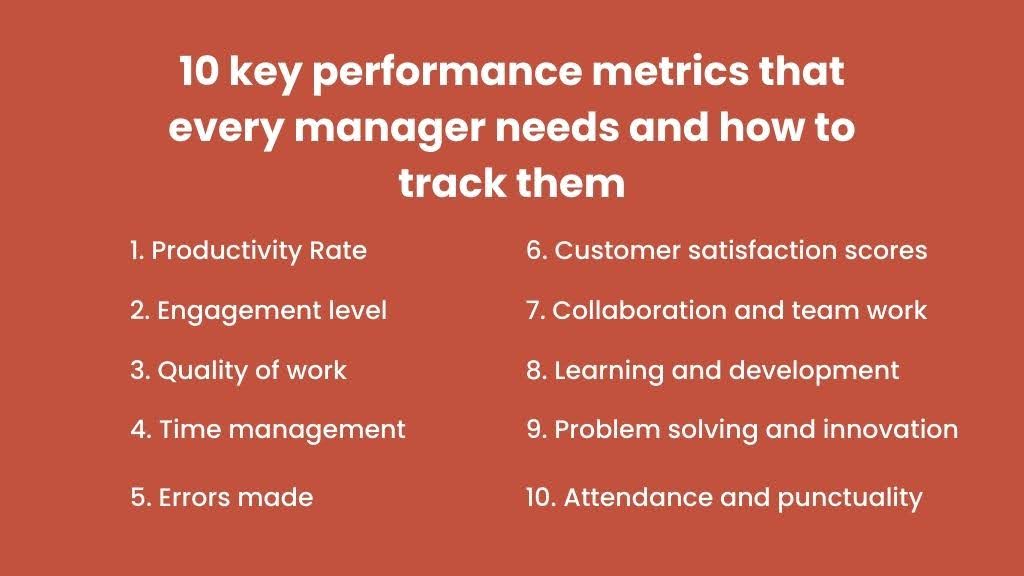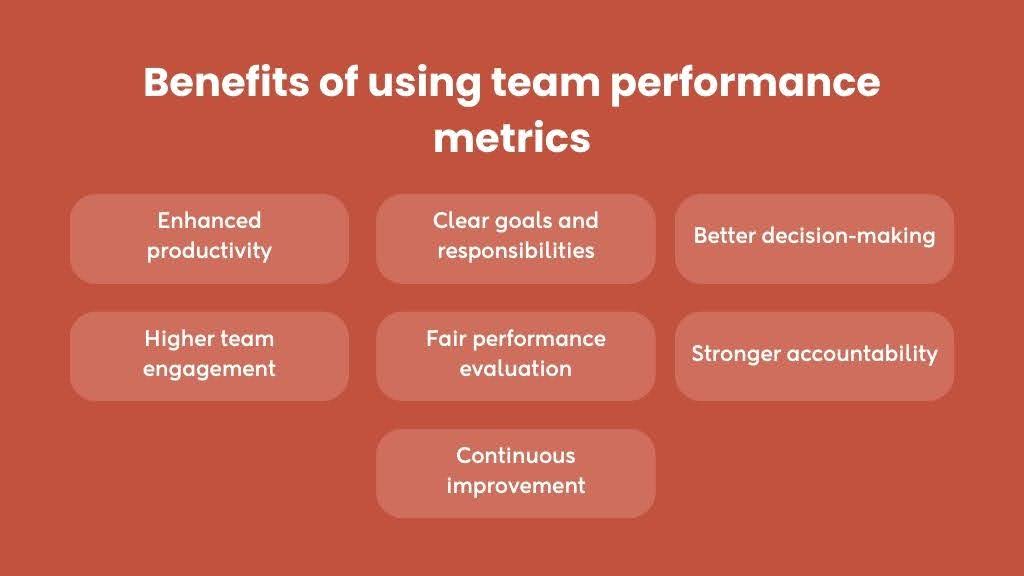It is every manager’s dream to see their team be engaged, productive, and improving constantly. Getting team members to work at their full potential is the pinnacle of management.
More than 33% of individuals prefer receiving continuous feedback instead of just an annual review. Companies that keep a regular eye on their team’s performance outperform their peers and experience a 30% higher revenue growth. However, managers can’t just measure performance and success based on their assumptions and gut feelings.
This is where data-driven team performance metrics come in. Using them, managers can track overall progress, identify strong areas, and uncover areas that need improvement. All in all, this leads to an efficient and stronger workforce. Still, each metric is different, and tracking multiple metrics can overwhelm managers.
In this post, we’ll discuss the key metrics that every manager should track, allowing them to make better decisions and foster productivity at the workplace.
What are team performance metrics and their importance?
Team performance metrics refer to a set of values that managers can measure in order to assess individual efficiency, performance, and productivity of their team. These metrics aren’t just raw numbers; managers can use this data to develop effective strategies that help foster an engaged, high-performing workforce.
Suppose the manager or the team leader has no idea about which individual is excelling, who needs improvement in certain areas, and who is struggling completely. In that case, it’s similar to driving a vehicle blindfolded. Performance metrics allow data-driven leadership and provide clarity. Managers can address challenges, measure productivity, recognize achievements, and allow team members to thrive.
10 key performance metrics that every manager needs and how to track them

Every single performance metric is unique, and management should know which ones to track. Tracking the wrong ones can mislead managers and hamper the efficiency of the workforce. The following are some key performance metrics that every manager should track –
1. Productivity Rate
The productivity rate helps track how efficiently an individual completes tasks within a certain time period. Managers get to know whether their team members are being efficient and completing their work on time.
How to track it:
- First of all, you need to make a list of weekly or monthly tasks.
- Divide the number of finished tasks by the total number of tasks to get the completion rate.
- For instance, if you had assigned an individual 10 tasks in a month and completed 8, their productivity rate is 80%.
A higher rate shows a productive team, while a lower rate signifies that they’re facing issues in their work.
2. Engagement level
Engagement level is a crucial metric as it tracks the level of involvement and commitment that an individual has towards his work and the company. Other than performance, this metric also tells how fun and engaging team members find it to work under their manager.
How to track it – Managers use a range of different methods to track their team’s engagement levels but the most common one is through surveys. It generally includes:
Conduct employee engagement surveys with questions related to commitment levels, sense of purpose, job satisfaction, etc.
- Hold 1-on-1 meetings to have a better understanding of how they feel about their roles and responsibilities..
- Monitor participation in team meetings, initiatives and social interactions as often high engagement generally shows up in these areas
A team that enjoys their work the most and is valued is more likely to stay productive and committed towards company goals.
3. Quality of work
Just because a task is completed doesn’t mean it’s done well.This metric helps track whether the work done by a team member meets the company’s quality standards or not. Analyzing this metric and its different factors allows managers to evaluate team performance in depth.
How to track it:
- Assess key quality indicators such as product defects, customer feedback, rework rates and adherence to guidelines
- Track customer satisfaction metrics like net promoter score so that external perceptions of work quality can be easily tracked
- Analyze work trends- is a team member frequently working overtime to complete tasks?
This facilitates managers to check all these variables related to an individual’s performance and aggregate them to get the quality of work done. You can even learn about the reasons behind underperformance, such as disengagement, lack of skill development, or anything else through this.
4. Time management
Time management showcases an individual’s ability to plan and allocate time to his tasks. Prioritizing tasks and controlling the amount of time spent on them is a vital skill to develop. When the team manages their time efficiently, it enhances their productivity levels. Bad time management leads to communication breakdowns and missed deadlines.
How to track it – You can use a project management and collaboration tool for assistance with time management and other work-related things. Real-time tracking, as well as different task views, allows managers and team members to stay on top of their projects. This visibility and transparency help track time as well as other performance metrics. Moreover, the team can collaborate efficiently on a single platform through the tool, making sure that all deadlines are met, and organizational goals are achieved.
5. Errors made
Another important metric to measure is the number of errors made by a team member. Sometimes errors happen due to accidents that the team cannot control. By identifying them, managers can make improvements, making sure that each individual can improve the quality of work done.
How to track it – Managers can compare the number of errors to the total error-free work done across a time period. This even helps assess an individual’s efficiency and productivity levels. If a team member is repeatedly making similar mistakes, then you can consider ways to help them improve.
6. Customer satisfaction scores
Customer feedback gives managers an overview of how content customers are with the services offered to them by team members. Happy customers will turn into repeat customers and tell others about your organization.
How to track it – You can assign a customer satisfaction score to team members based on the reviews given by customers handled by them. Ask your customers to rate every interaction they have with an individual. After identifying patterns in the feedback, you can use it to help team members improve.
7. Collaboration and teamwork
Team work and collaboration are a hallmark of high-performing teams. By tracking this metric, managers can make sure that team members find it seamless to collaborate among each other, leading to higher efficiency along with a friendly and positive work environment.
How to track it – The most effective way to track this metric is by assessing cross-team project success and the effectiveness of communication within the team. Also, you can take feedback from the team, evaluate their engagement, and their productivity to know about collaboration and teamwork.
8. Learning and development
Assessing learning and development of team members is really important for team growth, especially if the team is new. This makes sure that individuals can improve constantly, enhance their skills, and work in an efficient manner.
How to track it – Managers can track training completion rates, skill acquisition, knowledge retention, and overall progress to evaluate the level of learning and development of their team. If the level is low, then you can come up with new methods of training and helping individuals.
9. Problem solving and innovation
When team members are proactive at problem-solving and coming up with innovative solutions, it helps improve business growth and efficiency. They efficiently use their resources and are great at tackling challenges faced by them.
How to track it – Even though this metric can be a bit subjective in nature, managers can track it by evaluating the number of process improvements and new ideas suggested by an individual. Also, you can track the number of innovations implemented and problems solved without escalation for this.
10. Attendance and punctuality
Regular attendance and punctuality is crucial for teams to stay efficient and meet their deadlines. Performance and absenteeism are co-related, as highly-motivated individuals are less likely to take regular leaves. Also, low attendance can disrupt workflows and affect team productivity.
How to track it – The best way to track attendance is by using a biometric attendance system where team members punch in with their fingerprint or an access card. This makes sure that the timings are accurate and no individual can enter a wrong time, which is possible in manual attendance.
Benefits of using team performance metrics

Now that we’ve read about the important metrics that managers should track to analyze team performance, let’s read about their benefits –
- Enhanced productivity – Managers can identify both underperformers as well as top performers. This allows them to optimize workflows and offer the right support to enhance workplace productivity.
- Clear goals and responsibilities – Metrics allow managers to set measurable, specific, and achievable goals. Team members can understand their responsibilities better and work towards meeting the organization’s objectives.
- Better decision-making – Data-driven metrics help managers make informed decisions regarding task delegation, workforce planning, salary adjustments, promotion, and more.
- Higher team engagement – Regular tracking of team performance fosters motivation and transparency among them. It encourages them to stay engaged and committed to the organization’s success.
- Fair performance evaluation – Tracking of metrics makes sure that managers evaluate their team based on quantitative results instead of any personal bias or opinions. This ensures that there is no favoritism in the evaluation process.
- Stronger accountability – With regular tracking of performance metrics, individuals become more responsible for their tasks. They start owning up to their work, leading to better outcomes.
- Continuous improvement – Team performance tracking gives managers the ability to improve operations, refine workflow strategies, and implement efficient practices for long-term success.
Tips to implement team performance metrics in your organization
Just knowing about important metrics is not enough, as you also need to implement them correctly to track team performance. Here are some tips that managers can follow:
Align metrics with your company’s goals
First of all, you have to make sure that the metrics align with your organization’s long-term objectives. Based on the priorities and goals, you can set metrics that matter the most.
Find the right balance between qualitative and quantitative metrics
For a deep and well-rounded analysis of team performance, you should use a mix of qualitative and quantitative metrics. For example, you can combine attendance, productivity rate, etc., with problem-solving capability, customer reviews, and more.
Customize metrics based on job roles
Each organization has unique goals, and individuals follow different work strategies to achieve them. Make sure to customize performance metrics depending on the jobs and responsibilities of your team members.
Ensure metrics are transparent and measurable
Make sure that the metrics are not too complicated and follow clear and objective criteria. This way, it’s easier for managers to track them and communicate reports to team members. Individuals can understand the criteria behind these metrics and use them to be more efficient.
Regularly review and update metrics
Managers should evaluate the effectiveness and relevance of metrics regularly. As team roles and organizational goals evolve, you should update performance metrics accordingly. You can even ask for team members’ feedback to know if the metrics are actionable and fair for them.
Conclusion
Team performance metrics are not just a set of numbers; they help managers create a workplace culture where individuals can thrive and improve in all aspects of their work.
How would team members know whether to continue working in the same manner or change their approach if there is no assessment of their performance? The workforce, as well as the leadership, can make actionable, data-driven decisions that drive long-term success, with the right metrics in place.
Still, it is vital to align these metrics with your company’s goals, keep them measurable and trackable, and update them regularly. If you track performance metrics efficiently, they become the key to leading a motivated and high-performing workforce.

















No Comments